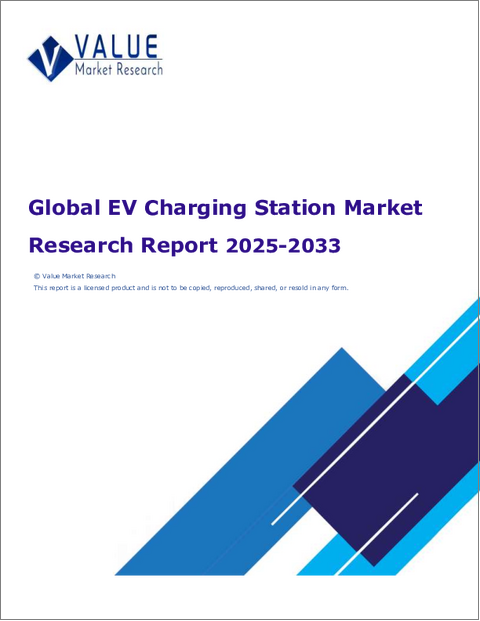|
|
市場調査レポート
商品コード
1782685
EV充電ステーションの世界市場調査レポート:産業分析、規模、シェア、成長、動向、2025年から2033年までの予測Global EV Charging Station Market Research Report- Industry Analysis, Size, Share, Growth, Trends and Forecast 2025 to 2033 |
||||||
カスタマイズ可能
|
|||||||
| EV充電ステーションの世界市場調査レポート:産業分析、規模、シェア、成長、動向、2025年から2033年までの予測 |
|
出版日: 2025年08月01日
発行: Value Market Research
ページ情報: 英文 187 Pages
納期: 即日から翌営業日
|
全表示
- 概要
- 目次
EV充電ステーションの世界市場規模は、2024年の235億8,000万米ドルから2033年には3,709億2,000万米ドルに成長し、2026~2033年の予測期間中に35.82%の堅調な年間平均成長率(CAGR)を示すと予測されます。
EV充電ステーション市場は、電気自動車(EV)の導入が世界的に増加し続けていることから、大きな成長が見込まれています。気候変動への懸念が高まり、サステイナブル輸送ソリューションの必要性が高まる中、政府と消費者は電動モビリティへの投資を進めています。EV充電インフラの拡大は、この移行をサポートするために不可欠であり、住宅、商業施設、公共スペースにおける充電ステーションの需要急増につながっています。メーカーやサービスプロバイダが、より高速な充電技術やユーザーフレンドリーなソリューションで革新を遂げるにつれて、EV充電ステーション市場はさらに拡大し、EV所有者の進化するニーズに対応していくと予想されます。
さらに、持続可能性の重視の高まりと政府のインセンティブは、EV充電ステーション市場に大きな影響を与えています。多くの政府が電気自動車の導入を奨励する施策や補助金を実施しており、その中には充電インフラ開発のための資金援助も含まれていることが多いです。このシフトは、包括的な充電ネットワークを構築し、消費者にとってEVをより身近なものにするために、官民双方からの投資を促しています。市場がこうした動向に適応していくにつれて、効率的で広範なEV充電ソリューションに対する需要の高まりが原動力となり、力強い成長が見込まれます。
さらに、技術の進歩がEV充電ステーションの能力を高めています。充電セッションをリアルタイムでモニタリング・管理できるスマート充電システムなどの技術革新は、全体的なユーザー体験を向上させています。さらに、太陽光発電などの再生可能エネルギー源を充電ステーションに統合することで、持続可能性を促進し、電動モビリティの二酸化炭素排出量を削減しています。EV充電ステーション市場がこのような動向と技術的進歩を受け入れ続けるにつれて、持続的な成長が期待され、電気交通への移行における重要な参入企業としての地位が確固たるものになると考えられます。
当社のレポートは、様々な産業や市場に関する包括的かつ実用的な洞察を顧客に提供するために綿密に作成されています。各レポートは、市場情勢を完全に理解するために、いくつかの重要な要素を含んでいます。
市場概要:定義、分類、産業の現状など、市場に関する詳細なイントロダクション。
市場力学:市場成長に影響を与える主要促進要因・抑制要因・機会・課題を詳細に分析します。このセクションでは、技術の進歩、規制の変更、新たな動向などの要因を検証します。
セグメンテーション分析:製品タイプ、用途、エンドユーザー、地域などの基準に基づき、市場を明確なセグメントに内訳。この分析により、各セグメントの業績と将来性を明らかにします。
競合情勢:市場シェア、製品ポートフォリオ、戦略的イニシアティブ、財務実績など、主要市場参入企業の包括的評価。主要企業が採用する競合力学と主要戦略に関する考察を記載しています。
市場予測:過去のデータと現在の市場状況に基づき、一定期間における市場規模と成長動向を予測します。これには、定量的分析と将来の市場軌跡を示すグラフ表示が含まれます。
地域分析:地域による市場パフォーマンスを評価し、主要市場や地域動向を明らかにします。地域の市場力学とビジネス機会を理解するのに役立ちます。
新たな動向と機会:現在の市場動向と新たな市場動向、技術革新、潜在的な投資対象セグメントを特定します。将来の開発と成長展望に関する洞察を記載しています。
目次
第1章 序文
第2章 エグゼクティブサマリー
- 市場のハイライト
- 世界市場スナップショット
第3章 EV充電ステーション-産業分析
- イントロダクション:市場力学
- 市場促進要因
- 市場抑制要因
- 市場機会
- 産業動向
- ポーターのファイブフォース分析
- 市場の魅力分析
第4章 バリューチェーン分析
- バリューチェーン分析
- 原料分析
- 原料リスト
- 原料メーカー一覧
- 主要原料の価格動向
- 潜在的バイヤーリスト
- マーケティングチャネル
- 直接マーケティング
- 間接マーケティング
- マーケティングチャネル発展動向
第5章 EV充電ステーションの世界市場分析:車種別
- 車種別概要
- 実績データと予測データ
- 車種別分析
- 乗用車
- 商用車
第6章 EV充電ステーションの世界市場分析:充電器タイプ別
- 充電器タイプ別概要
- 実績データと予測データ
- 充電器タイプ別分析
- AC充電ステーション
- DC充電ステーション
第7章 EV充電ステーションの世界市場分析:用途タイプ別
- 用途タイプ別概要
- 実績データと予測データ
- 用途タイプ別分析
- 公共
- 民間
第8章 EV充電ステーションの世界市場分析:地域別
- 地域別展望
- イントロダクション
- 北米の売上分析
- 概要、実績データ、予測データ
- 北米:セグメント別
- 北米:国別
- 米国
- カナダ
- メキシコ
- 欧州の売上分析
- 概要、実績データ、予測データ
- 欧州:セグメント別
- 欧州:国別
- 英国
- フランス
- ドイツ
- イタリア
- ロシア
- その他の欧州
- アジア太平洋の売上分析
- 概要、実績データ、予測データ
- アジア太平洋:セグメント別
- アジア太平洋:国別
- 中国
- インド
- 日本
- 韓国
- オーストラリア
- その他のアジア太平洋
- ラテンアメリカの売上分析
- 概要、実績データ、予測データ
- ラテンアメリカ:セグメント別
- ラテンアメリカ:国別
- ブラジル
- アルゼンチン
- ペルー
- チリ
- その他のラテンアメリカ
- 中東・アフリカの売上分析
- 概要、実績データ、予測データ
- 中東・アフリカ:セグメント別
- 中東・アフリカ:国別
- サウジアラビア
- アラブ首長国連邦
- イスラエル
- 南アフリカ
- その他の中東・アフリカ
第9章 EV充電ステーション企業の競合情勢
- EV充電ステーション市場の競合
- 提携・協力・契約
- 合併・買収
- 新製品発売
- その他の開発
第10章 企業プロファイル
- 企業シェア分析
- 市場集中度
- State Grid Corporation of China
- ABB
- Siemens
- Qingdao Tgood Electric Co. Ltd
- Tesla Inc.
Global EV Charging Station Market size is anticipated to grow from USD 23.58 Billion in 2024 to USD 370.92 Billion by 2033, showcasing a robust Compound Annual Growth Rate (CAGR) of 35.82% during the forecast period of 2026 to 2033.
The EV charging station market is poised for significant growth as the adoption of electric vehicles (EVs) continues to rise globally. With increasing concerns about climate change and the need for sustainable transportation solutions, governments and consumers are investing in electric mobility. The expansion of EV charging infrastructure is critical to supporting this transition, leading to a surge in demand for charging stations in residential, commercial, and public spaces. As manufacturers and service providers innovate with faster charging technologies and user-friendly solutions, the EV charging station market is expected to expand further, catering to the evolving needs of EV owners.
Moreover, the growing emphasis on sustainability and government incentives is significantly influencing the EV charging station market. Many governments are implementing policies and subsidies to encourage the adoption of electric vehicles, which often include funding for charging infrastructure development. This shift is prompting investments from both public and private sectors to establish comprehensive charging networks, making EVs more accessible to consumers. As the market adapts to these trends, it is likely to witness robust growth, driven by the increasing demand for efficient and widespread EV charging solutions.
Additionally, advancements in technology are enhancing the capabilities of EV charging stations. Innovations such as smart charging systems, which allow for real-time monitoring and management of charging sessions, are improving the overall user experience. Furthermore, the integration of renewable energy sources, such as solar power, into charging stations is promoting sustainability and reducing the carbon footprint of electric mobility. As the EV charging station market continues to embrace these trends and technological advancements, it is expected to experience sustained growth, solidifying its position as a key player in the transition to electric transportation.
Our reports are meticulously crafted to provide clients with comprehensive and actionable insights into various industries and markets. Each report encompasses several critical components to ensure a thorough understanding of the market landscape:
Market Overview: A detailed introduction to the market, including definitions, classifications, and an overview of the industry's current state.
Market Dynamics: In-depth analysis of key drivers, restraints, opportunities, and challenges influencing market growth. This section examines factors such as technological advancements, regulatory changes, and emerging trends.
Segmentation Analysis: Breakdown of the market into distinct segments based on criteria like product type, application, end-user, and geography. This analysis highlights the performance and potential of each segment.
Competitive Landscape: Comprehensive assessment of major market players, including their market share, product portfolio, strategic initiatives, and financial performance. This section provides insights into the competitive dynamics and key strategies adopted by leading companies.
Market Forecast: Projections of market size and growth trends over a specified period, based on historical data and current market conditions. This includes quantitative analyses and graphical representations to illustrate future market trajectories.
Regional Analysis: Evaluation of market performance across different geographical regions, identifying key markets and regional trends. This helps in understanding regional market dynamics and opportunities.
Emerging Trends and Opportunities: Identification of current and emerging market trends, technological innovations, and potential areas for investment. This section offers insights into future market developments and growth prospects.
SEGMENTATION COVERED IN THE REPORT
By Charger Type
- Fast
- Slow/Moderate
By Application
- Commercial
- Residential
By Connector
- J1772
- Mennekes
- GB/T
- CCS1
- CHAdeMO
- CCS2
- Tesla
By Level
- Level 1
- Level 2
- Level 3
By Vehicle Type
- Passenger Cars
- Commercial Vehicles
By Propulsion
- BEV
- PHEV
- COMPANIES PROFILED
- Siemens AG
- Eaton
- ChargePoint Inc.
- ABB
- Schneider Electric
- EVBox
- Webasto Group
- Tesla
- Blink Charging Co.
- EO Charging
- The above list can be customized.
TABLE OF CONTENTS
1 . PREFACE
- 1.1. Report Description
- 1.1.1. Objective
- 1.1.2. Target Audience
- 1.1.3. Unique Selling Proposition (USP) offerings
- 1.2. Research Scope
- 1.3. Research Methodology
- 1.3.1. Market Research Process
- 1.3.2. Market Research Methodology
2 . EXECUTIVE SUMMARY
- 2.1. Highlights of Market
- 2.2. Global Market Snapshot
3 . EV CHARGING STATION - INDUSTRY ANALYSIS
- 3.1. Introduction - Market Dynamics
- 3.2. Market Drivers
- 3.3. Market Restraints
- 3.4. Opportunities
- 3.5. Industry Trends
- 3.6. Porter's Five Force Analysis
- 3.7. Market Attractiveness Analysis
- 3.7.1 Market Attractiveness Analysis By Vehicle Type
- 3.7.2 Market Attractiveness Analysis By Charger Type
- 3.7.3 Market Attractiveness Analysis By Application Type
- 3.7.4 Market Attractiveness Analysis By Region
4 . VALUE CHAIN ANALYSIS
- 4.1. Value Chain Analysis
- 4.2. Raw Material Analysis
- 4.2.1. List of Raw Materials
- 4.2.2. Raw Material Manufactures List
- 4.2.3. Price Trend of Key Raw Materials
- 4.3. List of Potential Buyers
- 4.4. Marketing Channel
- 4.4.1. Direct Marketing
- 4.4.2. Indirect Marketing
- 4.4.3. Marketing Channel Development Trend
5 . GLOBAL EV CHARGING STATION MARKET ANALYSIS BY VEHICLE TYPE
- 5.1 Overview by Vehicle Type
- 5.2 Historical and Forecast Data
- 5.3 Analysis by Vehicle Type
- 5.4 Passenger Cars Historic and Forecast Sales by Regions
- 5.5 Commercial Vehicles Historic and Forecast Sales by Regions
6 . GLOBAL EV CHARGING STATION MARKET ANALYSIS BY CHARGER TYPE
- 6.1 Overview by Charger Type
- 6.2 Historical and Forecast Data
- 6.3 Analysis by Charger Type
- 6.4 AC Charging Station Historic and Forecast Sales by Regions
- 6.5 DC Charging Station Historic and Forecast Sales by Regions
7 . GLOBAL EV CHARGING STATION MARKET ANALYSIS BY APPLICATION TYPE
- 7.1 Overview by Application Type
- 7.2 Historical and Forecast Data
- 7.3 Analysis by Application Type
- 7.4 Public Historic and Forecast Sales by Regions
- 7.5 Private Historic and Forecast Sales by Regions
8 . GLOBAL EV CHARGING STATION MARKET ANALYSIS BY GEOGRAPHY
- 8.1. Regional Outlook
- 8.2. Introduction
- 8.3. North America Sales Analysis
- 8.3.1. Overview, Historic and Forecast DataSales Analysis
- 8.3.2. North America By Segment Sales Analysis
- 8.3.3. North America By Country Sales Analysis
- 8.3.4. United State Sales Analysis
- 8.3.5. Canada Sales Analysis
- 8.3.6. Mexico Sales Analysis
- 8.4. Europe Sales Analysis
- 8.4.1. Overview, Historic and Forecast DataSales Analysis
- 8.4.2. Europe by Segment Sales Analysis
- 8.4.3. Europe by Country Sales Analysis
- 8.4.4. United Kingdom Sales Analysis
- 8.4.5. France Sales Analysis
- 8.4.6. Germany Sales Analysis
- 8.4.7. Italy Sales Analysis
- 8.4.8. Russia Sales Analysis
- 8.4.9. Rest Of Europe Sales Analysis
- 8.5. Asia Pacific Sales Analysis
- 8.5.1. Overview, Historic and Forecast DataSales Analysis
- 8.5.2. Asia Pacific by Segment Sales Analysis
- 8.5.3. Asia Pacific by Country Sales Analysis
- 8.5.4. China Sales Analysis
- 8.5.5. India Sales Analysis
- 8.5.6. Japan Sales Analysis
- 8.5.7. South Korea Sales Analysis
- 8.5.8. Australia Sales Analysis
- 8.5.9. Rest Of Asia Pacific Sales Analysis
- 8.6. Latin America Sales Analysis
- 8.6.1. Overview, Historic and Forecast DataSales Analysis
- 8.6.2. Latin America by Segment Sales Analysis
- 8.6.3. Latin America by Country Sales Analysis
- 8.6.4. Brazil Sales Analysis
- 8.6.5. Argentina Sales Analysis
- 8.6.6. Peru Sales Analysis
- 8.6.7. Chile Sales Analysis
- 8.6.8. Rest of Latin America Sales Analysis
- 8.7. Middle East Africa Sales Analysis
- 8.7.1. Overview, Historic and Forecast DataSales Analysis
- 8.7.2. Middle East Africa by Segment Sales Analysis
- 8.7.3. Middle East Africa by Country Sales Analysis
- 8.7.4. Saudi Arabia Sales Analysis
- 8.7.5. UAE Sales Analysis
- 8.7.6. Israel Sales Analysis
- 8.7.7. South Africa Sales Analysis
- 8.7.8. Rest Of Middle East And Africa Sales Analysis
9 . COMPETITIVE LANDSCAPE OF THE EV CHARGING STATION COMPANIES
- 9.1. Ev Charging Station Market Competition
- 9.2. Partnership/Collaboration/Agreement
- 9.3. Merger And Acquisitions
- 9.4. New Product Launch
- 9.5. Other Developments
10 . COMPANY PROFILES OF EV CHARGING STATION INDUSTRY
- 10.1. Company Share Analysis
- 10.2. Market Concentration Rate
- 10.3. State Grid Corporation of China
- 10.3.1. Company Overview
- 10.3.2. Company Revenue
- 10.3.3. Products
- 10.3.4. Recent Developments
- 10.4. ABB
- 10.4.1. Company Overview
- 10.4.2. Company Revenue
- 10.4.3. Products
- 10.4.4. Recent Developments
- 10.5. Siemens
- 10.5.1. Company Overview
- 10.5.2. Company Revenue
- 10.5.3. Products
- 10.5.4. Recent Developments
- 10.6. Qingdao Tgood Electric Co. Ltd
- 10.6.1. Company Overview
- 10.6.2. Company Revenue
- 10.6.3. Products
- 10.6.4. Recent Developments
- 10.7. Tesla Inc.
- 10.7.1. Company Overview
- 10.7.2. Company Revenue
- 10.7.3. Products
- 10.7.4. Recent Developments





